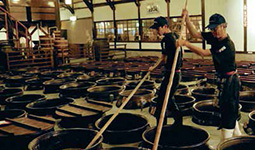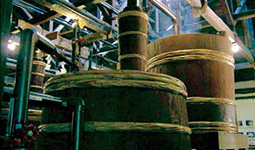INDEX

At the distillery, workers check the Satsuma potatoes for quality and trim them by hand 
Steamed and crushed sweet potatoes are mixed with rice koji mold and water to form a mash before transfer to the pot stills 
Shochu maturing in earthenware pots 
Traditional wooden pot stills are still used in Kagoshima Prefecture
June 2020
Satsuma Shochu: The Spirit of Kagoshima

Kagoshima Prefecture is located on the southernmost tip of the main island of Kyushu in southwestern Japan. Formerly known as Satsuma, the prefecture is well known for its sweet potatoes, or Satsuma Imo. By extension, the prefecture is also well known for its Satsuma Shochu, a spirit distilled from locally grown sweet potatoes which is winning fans around the world.

Japanese sake, a fermented liquor made from steamed rice and koji mold, is known to have been made for at least 1,200 years, since it is mentioned in the early-eighth century Fudoki manuscripts. Shochu, a beverage which may be distilled from a variety of ingredients, has a relatively short history, with origins in southern Kyushu only about 500 years ago.
Of the various main types of shochu, namely buckwheat, rice, barley, sugarcane and sweet potato, the sweet potato shochu of Kagoshima Prefecture is held in particularly high regard. Satsuma Shochu is made using sweet potatoes, water and rice or potato koji mold exclusively from Kagoshima Prefecture and is produced entirely within the prefecture, from the fermentation of ingredients to distillation, storage and bottling. Only shochu produced in this way can bear the Satsuma Shochu Mark confirming it has met the standards to be so certified as a Geographically Indicated (GI) product. Satsuma Shochu was granted GI status by the WTO in 2005, providing it the same kind of protection from misuse and imitation afforded to such global brands as Bordeaux and Champagne or Scotch. Ryukyu (Okinawa Prefecture), Kuma (Kumamoto Prefecture) and Iki (Nagasaki Prefecture) brand shochu have also been approved as GI products.
According to Nakatamari Yutaka of the Kagoshima Shochu Makers Association, “The history of potato shochu began when Maeda Riemon, a fisherman from southern Satsuma (modern-day Kagoshima Prefecture), brought sweet potatoes back from the Ryukyu Kingdom (modern-day Okinawa Prefecture) in 1705.”
The Shirasu-Daichi plateau, formed by volcanic eruptions and pyroclastic flows, covers much of southern Kyushu, including Kagoshima Prefecture. As the soil has excellent water drainage, it is not suited for rice harvesting, but it is extremely well suited for the cultivation of sweet potatoes. In the closing days of the Tokugawa Shogunate (1603–1867), the feudal lord encouraged the creation of shochu made from sweet potatoes, and the popularity of this Satsuma Shochu then quickly spread.
Today there are about eighty companies producing Satsuma Shochu in the prefecture.
The aroma and taste of the shochu varies according to brewery owing to differences in the sweet potato varieties and mold used, as well as to distillation methods. This means that a characteristic of the Satsuma Shochu brand is that one can find a shochu that pairs well with Japanese, Western, Chinese or any other type of food. It goes without saying that Satsuma Shochu goes particularly well with local specialties such as Kagoshima Kurobuta (black pig) pork, kibinago silver stripe herring sashimi and Satsuma-age oil-fried minced fish.
Satsuma Shochu is typically consumed on the rocks or mixed with hot or cold water. When mixing with hot water, Nakatamari recommends, “Rather than boiling water, add hot water at around 80°C to the glass first, and then add the shochu. Doing so causes a convection current where the hot water and shochu mix well and the aroma from the potato rises properly.”
Japanese distilleries enter more than 100 varieties in the shochu category of the International Wine & Spirit Competition held in November every year in London. The winner last year (2019) was a Satsuma Shochu called “Daiyame,” which was described by judges as being a “complex spirit with a fruity nose with floral elements such as rose,” and offering “a fluffy texture on the palate, good balance and a long finish.” Satsuma Shochu and other Japanese shochu also received high marks in the International Spirits Challenge and San Francisco World Spirits Competition.
Kagoshima Prefecture is blessed with hot springs and many scenic spots, including Mt. Kirishima, Mt. Sakurajima and Kinkowan Bay (see HJ February 2018 ). The famed local cuisine and Satsuma Shochu are two more big draws of this beautiful prefecture.





